Skip to comments.
The FReeper Foxhole Revisits the 57th. Bomb Wing & Operation Bingo (11-1944/4-1945)- Jan. 22nd, 2007
Originally Posted on 12/31/2003 3:00:24 AM EST by SAMWolf ^
| Frank B. Dean
Posted on 01/21/2007 6:11:53 PM PST by snippy_about_it
|

Lord,
Keep our Troops forever in Your care
Give them victory over the enemy...
Grant them a safe and swift return...
Bless those who mourn the lost.
.
FReepers from the Foxhole join in prayer
for all those serving their country at this time.

...................................................................................... ........................................... |
|
|
|
|
|
|
U.S. Military History, Current Events and Veterans Issues
 Where Duty, Honor and Country
Where Duty, Honor and Country
are acknowledged, affirmed and commemorated.
|

| Our Mission: The FReeper Foxhole is dedicated to Veterans of our Nation's military forces and to others who are affected in their relationships with Veterans. In the FReeper Foxhole, Veterans or their family members should feel free to address their specific circumstances or whatever issues concern them in an atmosphere of peace, understanding, brotherhood and support. The FReeper Foxhole hopes to share with it's readers an open forum where we can learn about and discuss military history, military news and other topics of concern or interest to our readers be they Veteran's, Current Duty or anyone interested in what we have to offer. If the Foxhole makes someone appreciate, even a little, what others have sacrificed for us, then it has accomplished one of it's missions. We hope the Foxhole in some small way helps us to remember and honor those who came before us.
To read previous Foxhole threads or
to add the Foxhole to your sidebar,
click on the books below.
|
|
|
|
|
Flak Guns In The Brenner Pass
On 6, November 1944 the Germans were holding the high ridges in the Northern Apennine mountains they called THE GOTHIC LINE. This defense line ran through the mountain ranges that reached, almost unbroken, from La Spezia on the north west coast of Italy to the City of Rimini on the Adriactic. Near the center and behind the German lines was the important transportation center of Bologna. Rail lines bringing war supplies from Germany, were for the most part routed through the Brenner Pass. Other rail lines from Austria were further east and led south into Venice and then into Bologna. These were the two main transportation lines that fueled the German machines in Italy.

It was estimated that 24,000 tons of supplies was flowing to the German troops each day. That was five times the minimum daily requirements needed to support the German troops that were locked in a winter stalemate with our Allied forces.
On the 6th. of November 1944, Operation BINGO was put into effect. It's objective was to stop the flow of German goods coming to the fighting front by closing off the Brenner Pass. The four B-25 bomb groups belonging to the 57th. Bomb Wing were to carry the bulk of the load. Fighter bombers of the 12th. Air Force's Tactical Air Command and the Desert Air Force (British) would assist. Some help would come from B-17's and B-24's of the 15th. Air Force.

Bombs Away.
A load of white phosphorous bombs heading down toward the gun emplacements protecting the the Orr Bridge at Brenner Pass.
Photo courtesy of Dave Mershon, 487th.
It was estimated that if electrical power could be denied the electrical driven locomotives that were used on the steeper grades, it would force the Germans to use more inefficient steam locomotives that would require part of the transportation effort to supply coal for these trains and also pull locomotives and rolling stock from their present activities. If this could be accomplished, it was estimated that it could reduce the carrying capacity in the Brenner Pass to around 10,000 tons a day.
On 6 November, the B-25's struck targets in the Brenner; the electrical transformer stations between San Ambrogio - hit by the 310th., through Ala - hit by the 321st., and Trento - hit by the 340th. The targets were all hit and destroyed or damaged to the extent that electrical power was denied to trains as far north as Balzano. The 319th., newly changed from B-26's to B-25's, hit railroad bridges in the lower end of Brenner.

The defense of the pass fell to the 2nd. Fighter Group of the Italian Facist Republic Air Force. These were Italian pilots flying Me-109's with German markings. With only about 50 planes these would not be the most effective deterrent. The primary defense fell to the German 5th. and 127th. Flak Regiments that manned the 366 heavy, anti-aircraft guns that were stationed from Verona, in the south, to Innsbruk, in the north. By the end of that day more heavy guns moved in around Ala and Rovereto.
In addition to the German gunners there were still Italians fighting along with the Germans. However the batteries were manned independently by either Germans or the Italians. The Italian gunners used an Italian cannon coupled with the German Radar.

319th Bomb Group
The German's main defensive weapon was the 8.8cm. Fliegerabwehrkanone, shortened to Flak. The 88 fired a 9.24KG (20.34 pound) shell to over 49,000 feet. It was coupled with the KG 40 gun director and the 41D gun laying radar. The gun director was a mechanical calculator with a stereoscopic height finder incorporated, capable of predicting a rectilinear or curvilinear course. The radar was capable of furnishing present azimuth, angular height and radar range to the gun director. Usually the gun batteries used radar tracking for range and optical tracking for direction. In cases where clouds or smoke obscured the bomb formations, radar controlled or barrage firing was used although it was not considered as effective as visual sighting.

Other guns were used also. The Italians made 90mm cannon, with a range of 26,000 feet and their 102mm cannon that reached to 40,000 feet were used to guard the Brenner Pass targets. While the larger guns were require to reach high flying B-17's and B-24's, lighter guns such the German and Italian 37mm cannon would reach up to 15,000 feet and the Italian 75mm ranged to 27,000 feet, were all effective against our B-25 Bombers who rarely flew above 13,000 feet. This meant any gun from a 37mm up could reach the medium bombers altitude. From the reports of the combat crews - they all did.

As the attacks increase on the Brenner Pass, targets of rail and road bridges, tracks and fills, the amount of flak guns increased. Batteries were added as far north as Bressanone. On the 11th. of November a flight of B-25's had 18 aircraft holed and one crash due to flak damage. Of the 16 attacks made during November, 11 had drawn flak. Of 300 sorties 20 B-25's were holed and one B-25 crashed.
In December 69 more guns were moved into the Brenner Pass by the Germans, making a total of 435. Anti-flak operations became standard practice by the 57th. Fighter bombers dropping general purpose bombs and the bombers dropping 20 pound fragmentation bombs and twisted pieces of tin foil called Chaff or Window (to confuse the radar) were tried.

Returning from a mission. 7T, 7Z and other aircraft of the 487th peeling off to land. August 1944 Alesan, Corsican
Photo courtesy of Dave Komigsberg, 487th.
At the end of December the 319th. Bomb Group flew it's last mission, over Italy, and returned to the U.S. in January of 1945. This left the 310th., the 321st., and the 340th. Groups the only medium bombers in the theater.
|
FReeper Foxhole Armed Services Links





TOPICS: VetsCoR
KEYWORDS: 57thbombwing; b25; brennerpass; freeperfoxhole; militaryhistory; operationbingo; veterans
Navigation: use the links below to view more comments.
first 1-20, 21-40, 41-60, 61-80 ... 281-288 next last
In January, 1945, flak batteries continued to increase. More guns moved into Bressanone and Verona. There were now 475 heavy guns guarding the Brenner. Some were stationed in the mountains as high as 3000 feet above sea level. One battery, west of Ala, was reported at the 4100 foot level. Anti-flak operations continued with a new twist, with a formation of three B-25 anti-flak planes leading the bombing formation, dropping chaff and white phosphorous bombs to burn the gunners and hide the formation with the smoke. Despite these efforts, of the 48 missions flown over the Brenner, 1250 sorties, that month, 39 drew flak, Two hundred and twenty four aircraft were holed and 5 lost.

In February, 1945, as our bomber pushed further into the Breeder the gun batteries shifted from the south to north. Guns increased at Trenton and Bressanone. New batteries appeared at Laves, and Breeder. The gun total in the Breeder rose to 482. It was rare now when a mission did not draw flak. This was due in part, to the refinement of the German early warning system. When the formations were within 200 kilometers of a defended area the gun batteries were alerted. When the formation was within 80 kilometers the guns were manned. Approximate course and altitude of the formation was given to the battery commander who waited for the formation to appear. There were practically no surprise attacks. In February 82 missions were flown over the Brenner (1771 sorties). Sixty two missions drew flak. Fourteen aircraft were lost and 305 were holed and damaged, despite our ant-flak operations.
March, 1945 and the flak batteries increased, especially in the north Brenner. Forty three new guns are added to the Brenner Pass defenses and the total of guns climbs to 525. Ninety six missions are flown over the Brenner Pass. Fifty eight draw flak. Fourteen aircraft were lost and 207 holed and damaged. However much of the Brenner was made impassable to the Germans during most of the month.

310th Bomb Group
In April, 1945 the final assault on GOTHIC LINE began. The attack on the Brenner is reduced in order to give ground support for the ground offensive. Many guns are removed from the Brenner to protect other vital targets.
The 57th. Bomb Wing moved, with its three bomb groups, from Corsica to northeast Italy in order to be closer to it's targets. During April there were only 64 missions flown against targets in the Brenner Pass. However 25 drew flak that holed 87 aircraft and downed five. These missions effectively kept the Brenner Pass lines cut.

During the offensive the B-25's of the 57th. spent much of their time bombing troops, guns, pontoon bridges, ferries and staging areas in an effort to prevent the Germans from crossing the Po River, and smashing rail lines and bridges that would offer an escape route back to Germany.
The blocking of the Brenner Pass and the slow strangulation of needed supplies only became apparent as the Germans tried to retreat to safety. Retreating troops were not able to use railroad lines, due to bridge spans missing. Shortage of ammunition and gasoline restricted motor transportation and reduced their fighting ability and effectiveness.

On the 26th. of April, 1945 the 340th. Group flew the last combat mission for the 57th. Bomb Wing. Bad weather grounded the medium bombers until the German forces signed surrender papers on the 29th. of April, 1945, to become effective the 2nd. of May, 1945.
From 6 November, 1944 to 25 April, 1945 the B-25's of the 57th. Bomb Wing had fought the "Battle of the Brenner". They flew over 6,849 sorties over enemy targets in the Brenner Pass. They had dropped 10,267 tons of bombs on the following targets - (south to north) Verona, Domagliara, San Ambrogio, Bolargne, Cerano, Dolce, Peri, Ossenigo, Vo Sinistro, Ala, San Margherita, Mori, Rovereto, Galliano, Aldeno, Terento, San Felice, San Michele, Lavis, Solorno, Ora, Brozolo, Ponte, All'Isarco, Bressanone, La Cave, Campo, Vipieno, Colle, Isarco, and Brennero. The B-25's ranged past these Italian targets and bombed Austrian bridges at Steinach and Matrei.The battle had not been without cost. During this shot period, 46 B-25's had been lost (2 to fighters). Flak had damaged 532 more. From 2 January, 1945, ten men had been killed and 131 were missing in action. Ninety two men had been wounded, 12 critically. The casualty count was 223 men from the 57th. If the B-25 had not been the exceptionally sturdy aircraft it was, the losses would have been far higher.

There had been the great inclusive war that everyone was aware of. There were smaller wars within the larger one, that generated a lot of killing but little publicity, And still smaller wars, unknown except by those who fought it.
One of these was "The Battle of the Brenner", fought between American Combat crews in the sky flying B-25 Bombers and German / Italian anti-aircraft crews on the ground. It was little noted or long remembered except by those who fought there. It had been mean and brutal while it lasted.

In the end, those who survived would return home, some are missing and some would return from prison camps. The wounded would carry their scars or disfigurement. The dead would remain dead, mourned only by those who knew them. Then as time passed there would be a time for remembering, even if time had dulled the memory and the log books lost. Then someone would search the scanty record and try to write enough to stir some old doormat memories.

This is one such story, written for those who flew in twin-tailed bombers and saw the red or black bursts of flak over the Brenner Pass in late 1944 and early 1945.
To: All
..........
One of the most important roles in the Mediterranean theater campaigns was played in aerial warfare by the 57th. Bomb Wing, A command composed of B-25 Mitchell medium bomber. Some of which began their combat history as early as the first landings in North Africa in November 1942. Since that time, the B-25's have participated in every major campaign from Tunisia to the final drive.

More than 60,000 missions by B-25's were flown to attacks in the eight campaigns they supported.The 310th., the 321st., and the 340th. Groups under the 57th. Bomb Wing have accounted for 52,098 of these sorties in 2,774 missions and dropped 71,934 tons of bombs on a great variety of targets. During this time the Mitchell's flew 165,573 combat flying hours.
The history of the bomb groups under the 57th. Bomb Wing reads in the order of the Mediterranean campaigns. After the North African landings came the battle of Kasserine Pass, a German counter offensive, the failure of which became the turning point of the war. From support of the North African landings, the B-25's flew to attack Axis concentrations and airfields in Tunisia, as well as carry out sea sweeps against enemy shipping. After Tunisia, the Mitchell's concentrated upon the small, heavily fortified Islands of Pantelleria and Lampedusa which threatened any future thrust toward Europe from the South. The aerial campaign against these two Islands resulted in the first surrender of troop solely from air attack without the aid of ground troops.

340th Bomb Group
Attacks were then extended from Africa to the mainland of Italy, Corsica and Sardinia. In June 1943, the B-25's entered a role they were to play for the next two years, the destruction of enemy communications. The Mitchell's were in the first medium bombardment of Italy and in July flew in the first attacks on the Rome area. This came only nine days after the invasion of Sicily which was heavily supported by the B-25's. In August the first attacks were made with the B-25G using the 75mm cannon in the nose.
September, 1943, brought Salerno and the hard, steady battle after the initial landings. Operations were directed against communications a short distance from the enemy lines cutting their avenues of support there as well as in the Naples area. By early October, the Mitchell's were operating from new bases in Italy and began their concentrated attacks against targets in the Balkans, resulting in the further destruction of the Luftwaffe. The B-25's also made the first attack of the war on Bulgaria from here.

Then came the reorganization of the Air Forces in the Mediterranean. The B-25's began operations under the British Tactical Bomber force, but later took their permanent place under the 57th. Bomb Wing which became an operational headquarters in January, 1944, Brig. Gen.. (then Col.) Robert D. Knapp became the commanding general.
The same month saw the invasion of Anzio and the unending support given from the air. Then came the unrelenting drive to isolate the Cassino battlefront by the bombardment of German communications in central Italy every day the weather would permit. The B-25's were the first to fly in the all out attack on Cassino. To conduct better the communications campaign, all of the 57th. Wing units were on Corsica, far behind the German lines, in April. From here they reached out across the sea to chop constantly at enemy rail and road links during the allied drive capture Rome.

This was followed quickly by the destruction of all bridges over the Po River, which paid dividends over nine months later. Corsica as a base proved valuable in the invasion of Southern France. The Mitchell's did some of the most outstanding work of the war against bridges, and gun positions. Attacks on Yugoslavia and even Austria were carried out from those bases. In November came the greatest undertaking medium bombers ever accepted and with amazing success. It was the Battle of Brenner, against the vital rail line between Germany and the Italian battle front. On January 26th, the line was cut or blocked in at least 18 locations, 15 of which had been created by the 57th. Bomb Wing.
Shortly before the final drive in Italy, the 57th. Bomb Wing swiftly moved into Northern Italy and when D-Day came it found them preparing to put the greatest effort ever known on the part of the medium bombers. In April 4.638 sorties were flown in close support of the British 8th., and American 5th. Army troops with attacks on enemy troop concentrations, supplies, defense areas, and communications. It was fitting indeed, when the B-25's flew their final missions - that of dropping leaflets on the enemy announcing the unconditional surrender of the German Armies in Italy.

Beginning in 1940, almost 10,000 B-25s entered Army and Air Force service, and some 2,000 more went into British, Soviet, Brazilian and U.S. Marine Corps service.
Appropriately, one of the finest bombers ever to fly was named for Brig. General Billy Mitchell the dauntless advocate of air power. The bomber first came to public attention in April 1942 when 16 modified B-25s were launched from the aircraft carrier Enterprise, flew nearly 700 miles to Japan, and attacked Tokyo and four other cities, their factories, shipyards, refineries and munitions factories.

Lt. Col. Jimmy Doolittle's raid on Tokyo, a psychological victory for Americans, incensed the Japanese, who retaliated by killing an estimated quarter million Chinese soldiers and civilians. The B-25 also served as a ship killer, first on antisubmarine patrols and later against surface vessels. In 1943, they nearly annihilated the Japanese convoy in the Battle of the Bismarck Sea - demonstrating Billy Mitchell's theory of aerial domination of the seas. Consequently, the Japanese never again put a convoy where it could be threatened by American Air power.

Because of the B-25's flying qualities it served a variety of non combat functions, including as a transport during and after World War II. Billy's Bomber or the Sweetheart of the Services ended its Air Force service in 1959 as a pilot trainer.
Additional Educational Sources:
www.b25.net
www.vectorsite.net
www.cavanaughflightmuseum.com
www.flygplan.info
www.web-birds.com
www3.uakron.edu
2
posted on
01/21/2007 6:12:50 PM PST
by
snippy_about_it
(Fall in --> The FReeper Foxhole. America's History. America's Soul. WWPD (what would Patton do))
To: All
Named after Gen. Billy Mitchell, the Army Air Corps' most famous figure of the 1920s and 1930s, the North American B-25 proved to be one of the best American weapons of World War II. First flown on August 19,1940, the B-25 was a rugged, adaptable and accurate medium bomber. Famed for its role in the Doolittle Raid on Japan, the B-25 served around the world and flew with several air forces. North American produced the Mitchell in many different models, nearly 10,000 B-25s in all.

The Mitchell proved to be highly flexible and was fitted with a wide variety of armaments. Some versions of the B-25 were armed with no less than fourteen forward firing .50 cal. machine guns; while other B-25s boasted a 75mm tank gun mounted in the nose. Besides being used as a horizontal bomber, the B-25 was used as a low-level attack and anti-shipping aircraft.

Since the end of World War II, B-25s have been used as private transports and are common participants at air shows. Today, "How `Boot That!'?", the crown jewel of the Cavanaugh Flight Museum's collection, is the most original flying B-25 anywhere in the world. Constructed in Kansas City, Kansas, the Army Air Force accepted this B-25 in August 1944. Assigned to the 380th Bomb Squadron, 310th Bomb Group, 57th Bomb Wing, the aircraft arrived in Italy shortly after its completion. From the fall of 1944 through late spring 1945, this aircraft completed more than eighty combat missions over northern Italy, southern Austria and what was Yugoslavia. The majority of these missions targeted rail bridges in the Brenner Pass, a 100 mile corridor through the Italian Alps which sheltered the main railway line from Germany to Italy. |
3
posted on
01/21/2007 6:13:18 PM PST
by
snippy_about_it
(Fall in --> The FReeper Foxhole. America's History. America's Soul. WWPD (what would Patton do))
To: James Ewell Brown Stuart; alfa6; Allen H; Colonial Warrior; texianyankee; vox_PL; Bigturbowski; ...

SARGE Says...
I Dug the Hole Now "FALL IN" to the FReeper Foxhole!

Good Monday Morning Everyone.
If you want to be added to our occasional ping list, let us know.
4
posted on
01/21/2007 6:14:48 PM PST
by
snippy_about_it
(Fall in --> The FReeper Foxhole. America's History. America's Soul. WWPD (what would Patton do))
To: snippy_about_it
Good evening, snippy!
Thanks for the new FOXHOLE thread. ;)
5
posted on
01/21/2007 6:16:51 PM PST
by
Soaring Feather
(I Soar, cause I can....)
To: snippy_about_it
Thanks for the ping.
These threads are a great source of military history and a tribute to all Veterans of all U.S. conflicts....
A compilation of all of them would yield a great illustrated history textbook. If you ever do such a project let me know,
I salute you.
6
posted on
01/21/2007 6:31:03 PM PST
by
KDD
To: snippy_about_it
7
posted on
01/21/2007 6:33:19 PM PST
by
bmwcyle
(If no one buys illegal drugs, we win the war on drugs)
To: KDD
Thanks for your kind words. I believe we have over three years of daily threads before we just couldn't handle doing it every day. Now it's once in a while when we can.
If we did a complilation it would most likely be on cd. We wouldn't dare profit from it but might make them available at cost.
Good idea, we know home schoolers use them and they make great reference material. Thanks for the push to get it done.
8
posted on
01/21/2007 6:34:59 PM PST
by
snippy_about_it
(Fall in --> The FReeper Foxhole. America's History. America's Soul. WWPD (what would Patton do))
To: Soaring Feather
Good evening feather. We are trying to get one up at least monthly. We'll probably never get back to daily but we'll do our best to keep the Foxhole alive and well!
9
posted on
01/21/2007 6:35:55 PM PST
by
snippy_about_it
(Fall in --> The FReeper Foxhole. America's History. America's Soul. WWPD (what would Patton do))
To: snippy_about_it
10
posted on
01/21/2007 6:36:06 PM PST
by
Professional Engineer
(You think herding cats is hard? Try herding Engineers.)
To: snippy_about_it
Yes, and you do, we just gots to have The FOXHOLE. ;)
To: Professional Engineer
Dang, I figured you for 100%. :-)
Sam's was less than mine. LOL.
12
posted on
01/21/2007 6:37:45 PM PST
by
snippy_about_it
(Fall in --> The FReeper Foxhole. America's History. America's Soul. WWPD (what would Patton do))
To: snippy_about_it; SAMWolf
Nice Post!
(I mean repost)
BTTT
13
posted on
01/21/2007 6:39:19 PM PST
by
Fiddlstix
(Warning! This Is A Subliminal Tagline! Read it at your own risk!(Presented by TagLines R US))
To: snippy_about_it
Thanks for another GREAT thread, Snippy! Make sure when you do the CD ... I get a copy!!!!
Since I'm away from home this weekend, I can't ping my list till tomorrow evening, so this BUMP will serve as a place holder till then.
Hope you all are getting the New Year off to a GREAT start!
Neil
To: Neil E. Wright
Thank you Neil. The New Year is full of blessings. I hope yours is going good as well.
15
posted on
01/21/2007 6:54:05 PM PST
by
snippy_about_it
(Fall in --> The FReeper Foxhole. America's History. America's Soul. WWPD (what would Patton do))
To: Fiddlstix
Ha! Repost it is. We have so many to choose from and it never hurts to see them again. :-)
16
posted on
01/21/2007 6:54:49 PM PST
by
snippy_about_it
(Fall in --> The FReeper Foxhole. America's History. America's Soul. WWPD (what would Patton do))
To: snippy_about_it
One well-known
B-25C of the 321st Bomb Group was nicknamed "Patches" because its crew chief painted all the plane's flak hole patches with high-visibility zinc chromate paint. By the end of the war, this aircraft had completed over 300 missions, was belly-landed half a dozen times, and sported over 400 patched holes. The airframe was so bent that straight-and-level flight required 8° of left aileron trim and 6° of right rudder, causing the aircraft to "crab" sideways across the sky.
17
posted on
01/21/2007 7:10:39 PM PST
by
F-117A
(Who is Jamil Hussein?)
To: snippy_about_it; SAMWolf; Peanut Gallery; alfa6; colorado tanker; Iris7; Wneighbor; Samwise; All
As promised, detail of Spiderboy's pinewood derby "car".
First coat of desert tan on the hull.
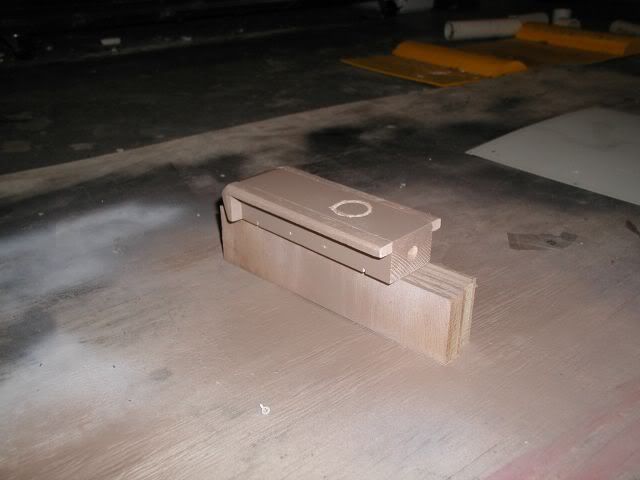
A couple of squirts of brown for variety.
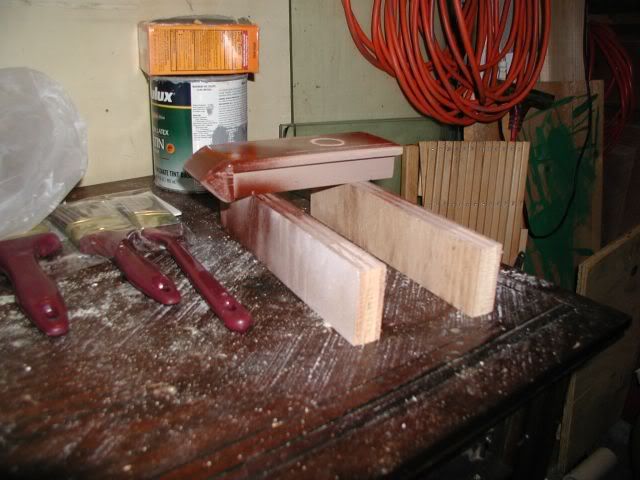
The 8-wheel drive is fitted. The middle axles are raised 1/8" for less drag on smooth terrain (race track) and to avoid complications if rules require 4 and only 4 wheels.
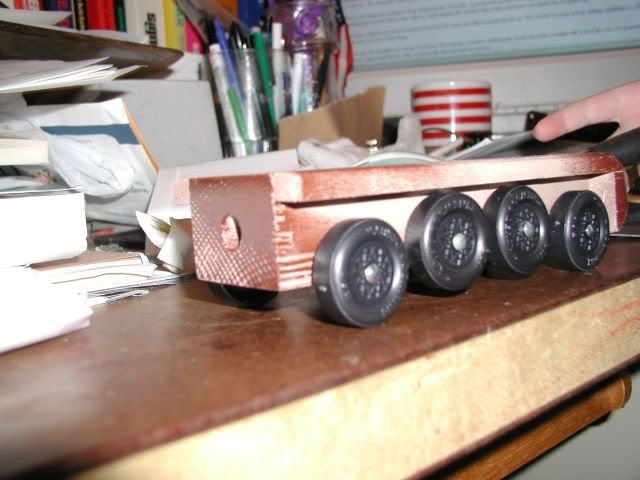
More Firepower is needed.
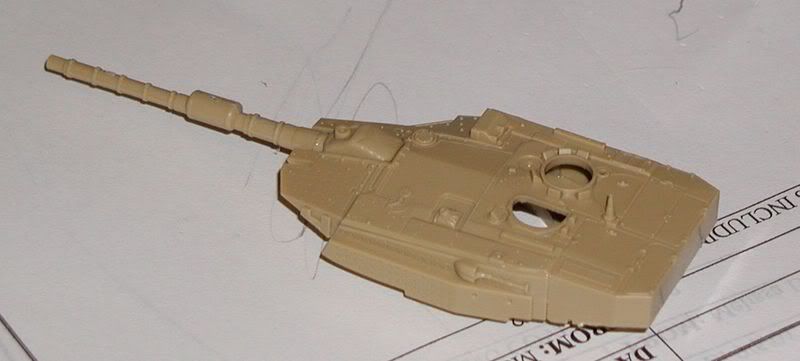
Final assembly.
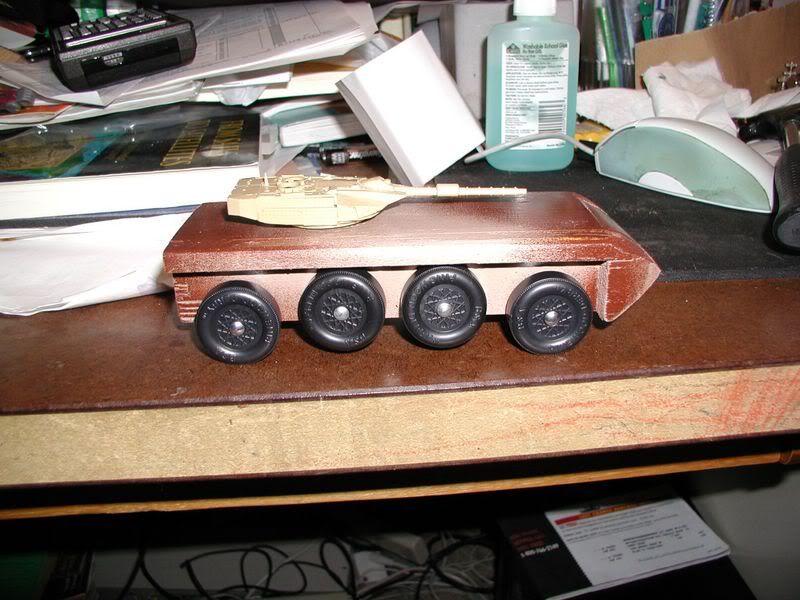
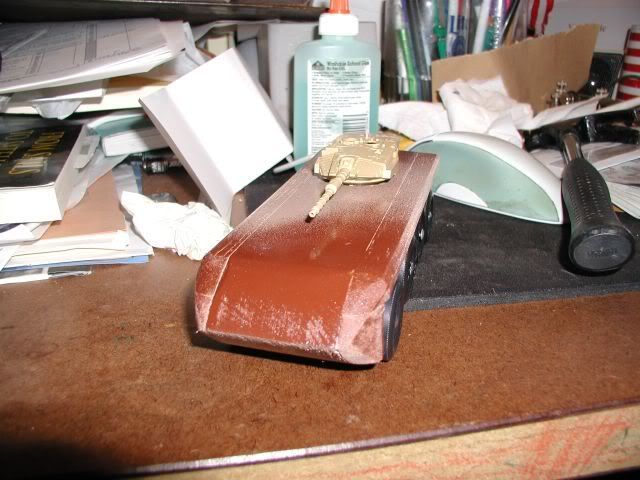
Bittygirl took this shot to illustrate the suspension qualities.
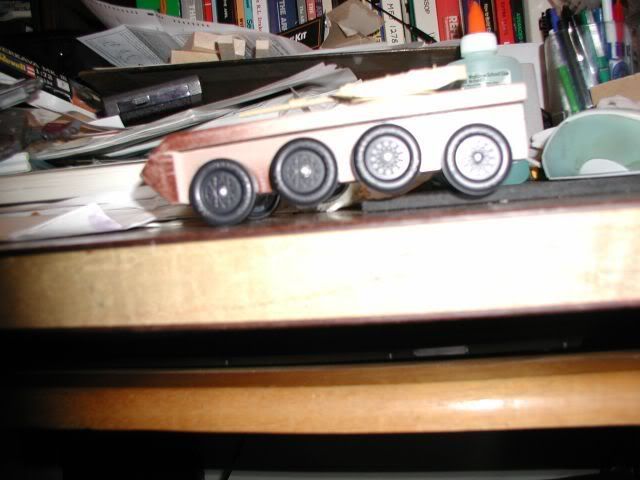
The prototype closest to the proportions of the pine block.


18
posted on
01/21/2007 7:14:38 PM PST
by
Professional Engineer
(You think herding cats is hard? Try herding Engineers.)
To: snippy_about_it
when 16 modified B-25s were launched from the aircraft carrier Enterprise, flew nearly 700 miles to Japan, and attacked Tokyo and four other citiesHornet. Enterprise provided escort for most of the operation.
I know you left that in so I could have the enjoyment of finding it.
19
posted on
01/21/2007 9:33:39 PM PST
by
PAR35
To: snippy_about_it
If we did a complilation it would most likely be on cd.Feel free to use any of my indexing. I'll send you all something in writing if you want it. At some point I'll get around to finishing the index. I've got to get the old computer working again first.
20
posted on
01/21/2007 9:41:03 PM PST
by
PAR35
Navigation: use the links below to view more comments.
first 1-20, 21-40, 41-60, 61-80 ... 281-288 next last
Disclaimer:
Opinions posted on Free Republic are those of the individual
posters and do not necessarily represent the opinion of Free Republic or its
management. All materials posted herein are protected by copyright law and the
exemption for fair use of copyrighted works.
FreeRepublic.com is powered by software copyright 2000-2008 John Robinson








































